The next-gen MacBook Pro with Retina Display Review
by Anand Lal Shimpi on June 23, 2012 4:14 AM EST- Posted in
- Mac
- Apple
- MacBook Pro
- Laptops
- Notebooks
All Flash Storage
As expected, the next-gen MacBook Pro ditches mechanical storage in favor of a MacBook Air style NAND + SSD controller on a custom PCB. Apple refers to this solution as all-flash storage.
Apple’s distinction between Solid State Drives (SSDs) and all-flash storage boils down to what form the storage comes in. If it’s a standard form factor device in a chassis, it’s a solid state drive. If it’s just NAND + controller on a PCB? Then it’s all-flash storage. I suspect it’s a nicer way of saying proprietary SSD but either way they are technically the same thing, just in different forms.
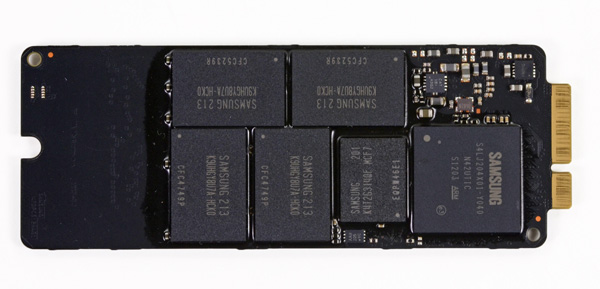
The Samsung PM830 based rMBP NAND flash storage card, image courtesy iFixit
My Retina MacBook Pro was the upgraded model with a 512GB SSD, featuring Samsung’s PM830 controller. This is the same controller as in the Samsung SSD 830, which I’ve long felt was the best pair for Mac users who wanted an SSD upgrade. I’m not sure if other Retina MBPs may come with Toshiba’s SandForce based drive instead. I have one of these drives in house for a review but that’ll have to wait until next week.
Although both the Samsung and Toshiba/SandForce controllers support full disk encryption, neither hardware based encryption is supported by OS X’s FileVault 2. When OS X encrypts your boot volume not all areas are encrypted (such as the recovery partition). While I know SandForce allegedly offers multiple encryption levels across a volume I’ve never seen either controller claim support for partially unencrypted volumes. In this case it looks like for Apple to take advantage of SSD controller based encryption it would need more flexible encryption support on the controller level. If I were an SSD controller vendor I’d be paying close attention to this requirement.
Both the Samsung and Toshiba controllers support 6Gbps SATA - as a result performance is significantly better compared to previous Apple branded SSDs. I borrowed a friend’s 2010 MacBook Pro which happened to have a Toshiba based SSD installed and ran it through our standard Iometer four-corners test suite. This was a well used drive and thus the performance is even worse than last year's MacBook Airs. The improvement in performance is astounding:
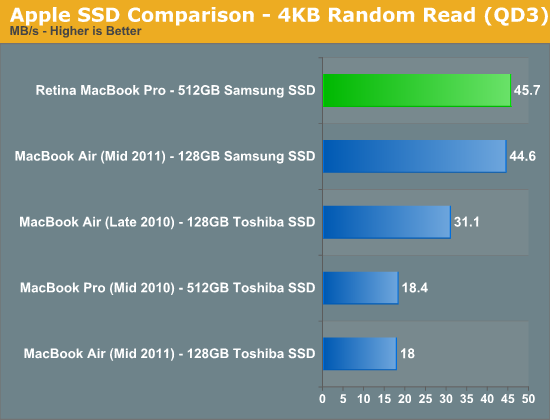
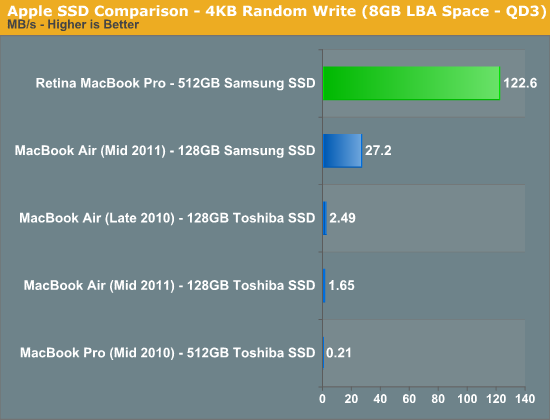
The move to 6Gbps SATA is often associated with a huge bump in sequential transfer rates, but in this case Apple enjoys a significant increase in random speeds as well. Note that some of this improvement is going to be due to the fully populated configuration of the PM830 in the Retina MacBook Pro's SSD, but that shouldn't downplay the significance of the move to Samsung's latest controller. The previous generation controller used last year just wasn't very good, and the Toshiba alternative was even worse. This year, Apple finally has a good solid state story to tell.
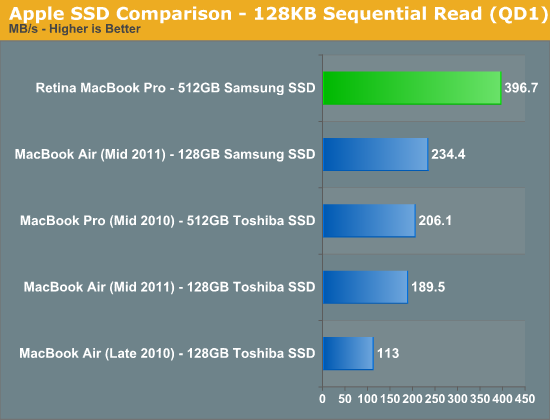
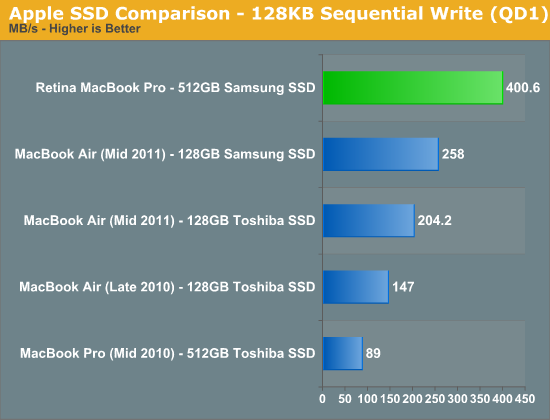
How much of this are you going to be able to actually tell in day to day use of the system? The sequential transfer rates are most tangible when you are writing to or reading large files like movies to your drive. Obviously you need a source that's fast enough to hit these speeds. Although USB 3.0 can come close you're unlikely to have a USB 3.0 SSD that's as fast as the internal drive. Moving large files between your internal SSD and Promise's Pegasus R4/R6 is where you'll really appreciate this performance.
The random access improvements are likely overkill for most normal uses. Things like program launches, compiling, web browsing, and any other normal application IO will depend on a mixture of random and sequential IO. The key is to have good enough random IO performance to avoid becoming a bottleneck. I can safely say that the numbers we see here are more than enough.
While previous Apple SSDs were nice only from a convenience standpoint, at least the Samsung option in the Retina MacBook Pro is what I’d recommend even if Apple didn’t bundle it with the machine.










471 Comments
View All Comments
Fx1 - Monday, June 25, 2012 - link
It makes a big difference to the glare when you take away that glass. Why don't you go have a look at a rmbp and see how thin the lid is and you too will be impressed. A LOT of work must going into designing these notebooks. Why don't you spend you time bitching at the windows notebook makers and see how CRAP their designs are. Because they deserve it. Full Stop.Spunjji - Tuesday, June 26, 2012 - link
Why don't you go and eat a dick, child.gstrickler - Wednesday, June 27, 2012 - link
It's not a matte screen. Matte screens are etched to diffuse the light in many directions. This makes them slightly less "sharp", and lowers their effective brightness slightly. The Retina display in the new MBP has a low reflectance flat surface, not a matte surface. It's an important difference as an etched surface would compromise the sharpness of such a high DPI display.Spunjji - Monday, June 25, 2012 - link
I give up. Too many fanboys on both sides.jjbwbc - Monday, June 25, 2012 - link
I bought one of these guys and I really love the display but I cannot for my life see if this is glass or plastic or what makes the outer layer of this display.How fragile is it? I mean, it seems like a combination of durable and extremely fragile too. Makes me nervous... can anyone weigh in on how fragile the screen on this guy is compared to regular LCDs?
Constructor - Thursday, June 28, 2012 - link
It's definitely glass, and likely of the 'Gorilla' variety. It will still scratch or break if you try hard enough. But with no access to Apple's internal QA information we'll have to wait until someone actually manages to break theirs to really know...! ;-)SimaYi - Monday, June 25, 2012 - link
I'm disappointed in this review, as I was very much hoping to get some advice about whether this laptop can run recent games at 2880x1800.The only frame rates mentioned for this resolution were Half Life 2 (42 fps) and Diablo 3 (18 fps).
@Anand, is there any chance you will update this article with some detailed feedback about gaming at 2880x1800, and framerates for running recent Windows games in bootcamp at this res?
seapeople - Monday, June 25, 2012 - link
No, it can't run recent games at 2880x1800. This is not something that needs to be benchmarked; it is obvious from the combination of a middle-of-the-road laptop graphics card and the highest resolution notebook screen ever made.wfolta - Monday, June 25, 2012 - link
And you got this idea, despite the article mentioning Diablo III (about as recent of a game as you can get)? It runs Diablo III (Normal Act III) at 20+ FPS, with most settings cranked to max. It runs other recent games fine. Perhaps you should give details of what games you mean when you say "recent"?And the fact is you can run games at lower resolutions (which still look better at that resolution than if you only had that many pixels) and drop a few settings and double your frame rate.
SimaYi - Tuesday, June 26, 2012 - link
Thanks very much for the feedback!Are you saying from personal experience that it runs D3 on High at 20fps? How about if you reduce the settings, say with no AA and lower setttings, can it run D3 above 30fps?
For most games, 25-30 fps is quite playable. Above 30fps is great.
As for "recent" games, I would be extremely interested to know the performance at 2880x1800 (on low or med settings), for games like Skyrim, DXHR, RAGE, Arkham City, BF3, Sniper Elite V2, ME3, Risen 2, MW3, Witcher 2, Civ 5.
Never purchased a mac laptop before and this is the first time I'm seriously considering it, primarily because of the display. However, if I can't run any games at 2880x1800, it seems like a waste.
Trying to decide between either buying an MBP or a Windows laptop with 1080p display and decent GPU, along the lines of a DV6t (Nvidia 650m) or Envy 15 (AMD 7750m).
I wouldn't call the 650m necessarily "middle of the road," as it's one of the fastest mobile cards currently available for laptops that are not bulky desktop replacements. Do Mac laptops run games slower on bootcamp compared to Windows laptops with the same card?